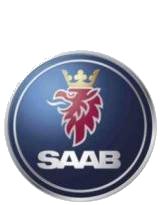- S
-
- A letter rating for tires to indicate that they are theoretically rated for speeds up to 180 kph (110 mph), as in P220SR15. The next higher rating is T.
- Abbreviation for Special or Sport, indicating better performance than a standard car model.
- SA
- An API classification for straight mineral oil used in early gasoline and diesel engines which are operated under such mild conditions that the protection of compounded oils is not required. This category has no performance requirements, and oils in this category should not be used in any engine unless specifically recommended by the equipment manufacturer. It was replaced by the obsolete SB. Modern gasoline engines should use oil that meets the SM classification.
- Saab
- A model of automobile manufactured in Sweden and includes 9-2X (2005-06), 9-3 (1999-current), 9-5 (1999-current), 9-7X (2005-07), 900 (1978-98), and 9000 (1985-98)
- Sacrificial anode
- An electropositive metal coating, such as aluminum or zinc, that protects the steel of a car body by corroding first when attacked by electrolytic action
- Saddle
-
- Seat on a bicycle
- Metal piece on a centerpull brake.
- Upper main bearing seat
- Saddlebag
- A large bag or one of a pair which hangs down from the saddle or straddles the rear wheel of a bicycle or motorcycle. Also called panniers
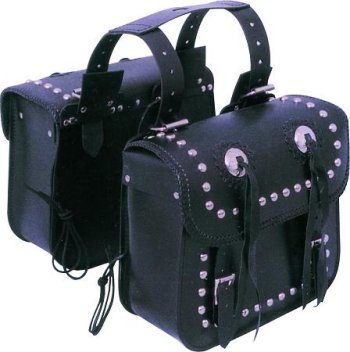
Saddlebag
- Saddle gel
- A gelatin substance that is inserted into a bicycle or motorcycle saddle beneath the leather cover to provide more cushioning.
- Saddle tank
-
- A fuel tank mounted above the rear axle.
- A fuel tank that fits over the top tube of the frame of a motorcycle
- Saddle valve
- A device that is silver brazed or clamped on a tubing line or pipe where a spike punctures the line or a hole is drilled in the line to provide a secondary outlet of the liquid in the line. Also called tap-a-line
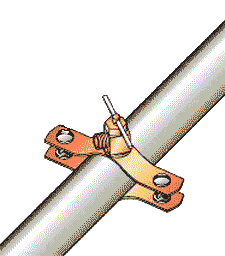
Saddle valve
- SAE
- Abbreviation for Society of Automotive Engineers. It publishes automotive research papers and defines various automotive standards of measurement.
- SAE gross bhp
- An older unit of engine power. In the SAE gross bhp test, a bare engine is used, i.e., an engine equipped with only those accessories that are necessary for its operation, such as the oil pump and fuel pump; but water pump, alternator, exhaust system, etc. are not used; this results in a higher power rating than achievable by the same engine under real operating conditions
- SAE gross horsepower
- A production engine's actual power available at the flywheel or output shaft (usually crankshaft) as tested with an absorption dynamometer. It differs from SAE net horsepower in that many of the accessories (such as alternator, water pump, etc.) are not attached. Engines before 1973 were primarily measured with these 'gross' numbers. Since 1973, net figures were published. This confusion caused many people to suppose that their engine had been seriously de-tuned when they saw that the same engine in 1972 had 400 hp but in 1973 had only 235 hp. (This example is from the Cadillac 500 cubic inch engine). Compare SAE net horsepower.
- SAE horsepower
- A simple formula of long standing is used to determine horsepower. The formula is (bore diameter) squared times (number of cylinders) divided by 2.5. This formula is used primarily for licensing purposes and is not very accurate for determining actual brake horsepower. Also called rated horsepower. Compare SAE gross horsepower and SAE net horsepower. See
- SAE net bhp
- A newer unit of engine power. A fully-equipped engine (as when installed in a vehicle) is used to determine SAE net bhp figures; as a rough guideline, SAE net is about 70-85 percent of SAE gross
- SAE net horsepower
- The brake power (power available at the flywheel or output shaft -- usually the crankshaft) of a fully equipped engine fitted with all the accessories necessary to perform its intended functions unaided. In 1973, automobile manufacturers began publishing their engine specifications in net horsepower and net torque instead of gross figures. In many cases the published numbers were significantly lower in 1973 than in 1972. Some of the decrease was attributed to the addition of pollution equipment, the lowering of compression, and the use of regular unleaded gasoline instead of premium leaded fuel. However most of the decrease in number was a switch to net figures. Compare SAE gross horsepower.
- SAE Standard Screw Threads
- The SAE Screw Thread Standard, as revised in 1954, conforms with the Unified and American Standard.
- Safe stop wheel
- A Run-on tire
- SAFETEA-LU
- Abbreviation for Safe, Accountable, Flexible, and Efficient Transportation Equity Act - a Legacy for Users
- Safety bead seat
- A general term for a safety contour on the rim bead seat preventing the tire bead from sliding into the rim well especially during cornering maneuvers
- Safety can
-
- Approved container of not more than 5-gal. capacity. It has a spring-closing lid and spout cover. It is designed to relieve internal pressure safely when exposed to fire.
- An approved container of not more than two gallons capacity having a spring-closing lid and spout cover and so designed that it will safely relieve internal pressure when subjected to fire exposure.
- Safety catch
- A secondary latch usually located under the front edge of the hood, near the center, which prevents accidental release of the hood if the main cable-operated hood lock is activated by mistake
- Safety chains
- Two, crossed chains linking the trailer and vehicle frame as a safeguard if the towing hitch fails

Safety chains
- Safety Compliance Certification Label
- (SCC) An American label which must be attached to the lower half of the left-hand front door lock facing; specifies the VIN and other relevant information
- Safety control
-
- Device to stop the operation of a unit if unsafe pressure, temperatures, and/or dangerous conditions are reached.
- Automatic controls and interlocks (including relays, switches, and other auxiliary equipment) which are intended to prevent unsafe operation of the controlled equipment.
- Safety-control circuit
- A circuit or portion thereof involving one or more safety controls aimed at preventing unsafe operation of the controlled equipment due to grounding, opening or shorting of any part of the circuit.
- Safety factor
-
- Providing strength beyond that needed, as an extra margin of insurance against part failure.
- Degree of strength above normal requirements which serves as insurance against failure
- Safety goggles
- A close-fitting glasses or mask to protect the eyes (e.g., during welding)
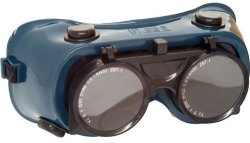
Safety goggles
- Safety hub
- A device that is installed on the rear axle to prevent the wheels from leaving the vehicle in the event of a broken axle.
- Safety ledge
- A raised area (hump) around the circumference of the bead seat area of passenger wheels. Its function is to prevent the tire beads from becoming unseated during hard cornering or while running with low air pressure. A must with tubeless passenger tires. Also called Special ledge
- Safety motor control
- Electrical device used to open circuit to motor if temperature, pressure, and/or current flow exceed safe conditions.
- Safety plug
- Device which will release the contents of a container before rupture pressures are reached.
- Safety relief valve
- A spring-loaded valve designed to open and relieve excessive pressure in a device when it exceeds a predetermined safe point
- Safety rim
- A rim having two safety ridges, one on each lip, to prevent the tire beads from entering the drop center area in the event of a blowout. This feature keeps the tire on the rim.
- Safety shutdown
- The action of shutting off all fuel and ignition energy to the fuel utilization equipment by means of a safety control or controls such that restart cannot be accomplished without manual reset.
- Safety shutoff device
- A device that will shut off the fuel supply to the controlled burner in the event the source of ignition fails. This device may interrupt the flow of fuel to the main burner only, or to the pilot and main burner under its supervision.
- Safety stand
- A device that can be securely locked at a choice of heights, so it can be placed under a specific part of the vehicle underbody to support the weight of the vehicle that has been raised with a jack, and keep the vehicle safely in place. Usually used in pairs. Also called jack stand or axle stand
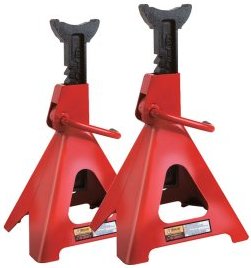
Safety stand
- Safety valve
-
- A valve designed to open and relieve the pressure within a container when container pressure exceeds a predetermined level.
- Self-operated, quick opening valve used for fast relief of excessive pressures.
- Safety valve shutoff
- A valve that is automatically closed by the safety control system or by an emergency device. Such valve may be of the automatic or manually opened type.
- Safety wheel
- A general term referring to either a wheel with a safety bead seat or a wheel with run flat properties
- SA-FV
- Abbreviation for Separator assembly-fuel Vacuum
- Sag
-
- To bend or droop under weight or pressure. As a result of a front or rear end collision, the frame may develop a sag in the middle, much like a hammock.
- To fail to meet projected sales.
- A paint problem.
- Sagging
-
- An aggravated condition of paint where a band of paint runs down the side of a vertical area of the body. It may be caused by excessive build-up of paint, thinners which are too slow-acting, or excessively slow movement of the spray gun.
- The straining of a ship that tends to make the middle portion lower than the bow and stern
- Sagging door
- A door that sits too low in the door opening which is often indicated by an uneven door gap that widens towards the rear bottom and front top of the door but narrows down at the rear top and front bottom. This condition may be caused by faulty setting of the door hinges and lock/striker assembly. On convertibles, it often pinpoints structural damage, because the chassis may be bending in the middle
- Sags
- An aggravated condition of paint where a band of paint runs down the side of a vertical area of the body. It may be caused by excessive build-up of paint, thinners which are too slow-acting, or excessively slow movement of the spray gun
- Sag wagon
- A support vehicle for touring bicycles or motorcycles to provide food, repairs, or a ride home.
- SAI
- Abbreviation for Steering axis inclination
- Sail Panel
- The somewhat triangular panel behind the rear side window as the final support for the roof. Also called quarter window.
- SALA suspension
- Abbreviation for Short arm/long arm suspension
- Salient pole
- An electric motor has salient poles when its stator or field poles are concentrated into confined arcs and the winding is wrapped around them (as opposed to distributing them in a series of slots)
- Saloon
- A British term for sedan
- Salt flat
- Salt marsh of very unreliable consistency and bearing strength found in desert regions and characterized by a top crust of varying thickness and strength with soft salt mud of great depth beneath it.
- Salt spray chamber
- A test chamber for Salt spray testing
- Salvaged
- A vehicle totaled in an accident and then repaired. There is no guarantee of street worthiness for a salvaged vehicle. It may look good, but be hazardous to drive.
- Sam Browne
- A wide strap, made of reflective material, worn around the waist with a strap diagonally over the right shoulder
- Sand
-
- To smooth or clean a surface by rubbing with sandpaper. Sanding usually refers to hand tools such as sandpaper and block, while grinding always refers to power tools such as angle grinders.
- A term popularly applied to loose, unconsolidated accumulations of detrital sediment, consisting essentially of rounded grains of quartz. In the mechanical analysis of soil, sand, according to international classification, has a size between .06 and 2.0 mm.
- To apply a thin layer of sand or sand and salt to an icy road surface to increase traction.
- Sand blaster
- A metal box into which a rusty or dirty object is placed. Compressed air and sand or grit are forced through a nozzle and is directed at the object in order to remove the dirt, paint, or rust.
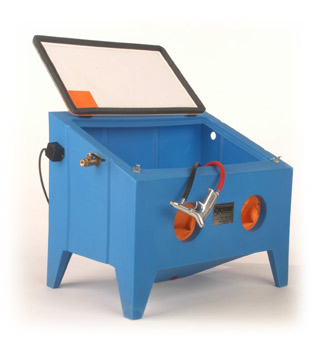
Sand blaster
- Sand casting
- The formation of shapes by pouring molten metal into a cavity shaped in sand in a molding flask
- Sand channels
- Open face tubes or planks (sometimes articulated) with a rough inner surface with ridges used to put under the driving wheels to assist in gaining traction when the vehicle is stuck in soft sand.
- Sander
- A power-driven tool with a rotating abrasive disc for smoothing and cleaning surfaces.
- Sanding block
- A block of rubber or plastic to which the sandpaper is fastened, offering the operator a good grip. The block should be used for most sanding jobs because it distributes the pressure evenly and gives a more uniform surface.
- Sand ladders
- A pair of aluminum ladders, about 170 cm long, specially made with rungs closer than normal, to lay beneath the vehicle wheels in soft sand to give grip and flotation.
- Sandpaper
- An abrasive paper coated with sand for smoothing and cleaning. Compare Glasspaper
- Sand recycling
- Collecting road sand used one winter and processing it for reuse the next winter or for other applications
- Sand scratches
- The marks left in metal or in the old finish by abrasives. They may also show in the finish coat due to lack of filling or sealing.
- Sand scratching
- A paint fault characterized by the paint film appearing low in gloss and showing primer and metal imperfections in the top coat; may be caused by excessively coarse sanding and too thin a paint coat
- Sand tires
- An off-road tire designed for desert sand and beach sand. Usually with smooth tread blocks rather than the sharp, bold blocks of a mud tire.
- Sand tracks
- Generic name sometimes given to any item fulfilling the role of a sand ladder. May be pierced steel planking
- Sandwich construction
- A composite construction of alloys, plastics, and other materials consisting of a foam or honeycomb layer and glued between two hard outer sheets. Also called Sandwich laminate
- SAS
-
- Abbreviation for Scandinavian Automotive Suppliers
- Abbreviation for speed adjusting screw
- SASE
- Abbreviation for self-addressed stamped envelope. Often used in advertisements where the seller will provide information if potential buyers will send a SASE enclosed in their query letter. See
- SSAE.
- Saturated vapor
- Vapor condition which will result in condensation into droplets of liquid if vapor temperature is reduced.
- Saturation
- Condition existing when substance contains all of another substance it can hold for that temperature and pressure.
- Saturation period
- The length of time the breaker points are closed and current is flowing through the primary windings of the coil.
- Saturn
- A make of automobile manufactured by General Motors. Includes
- Aura (2007-current)
- Ion (2003-07)
- L100 (2001-02)
- L200 (2001-03)
- L300 (2001-05)
- LS (2000)
- LS1 (2000)
- LS2 (2000)
- LW1 (2000)
- LW2 (2000)
- LW200 (2001-03)
- LW300 (2001-03)
- Outlook (2007)
- Relay (2005-07)
- SC (1991-92)
- SC1 (1993-02)
- SC2 (1993-2002)
- SKY (2007-current)
- SL (1991-2002)
- SL1 (1991-2002)
- SL2 (1991-2002)
- SW1 (1993-99)
- SW2 (1993-2001)
- VUE (2002-07)
- Saturn Aura Green Line
- A midsize Hybrid sedan produced by General Motors similar to the Chevrolet Malibu Hybrid that uses a Belt Alternator Starter (BAS) hybrid system.
- Saybolt Furol viscosity
- A viscosity test similar in nature to the Saybolt Universal viscosity test but one more appropriate for testing high-viscosity oils. Certain transmission and gear oils, and heavy fuel oils are rated by this method. The results obtained are approximately 1/10th the viscosity which would be shown by the Saybolt Universal method.
- Saybolt viscometer
- An instrument used to determine the fluidity or viscosity of an oil.



